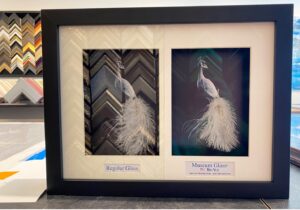Choosing the right type of glass for your art
Choosing the type of glass or acrylic to frame your art is a key part of the design. Here we discuss the different features of each to help you decide which product to use. Plus, our “take” on each!
Download the white paper: Choosing the right type of glass for your art
Museum Glass/Acrylic*:
Features
- Virtually eliminates reflections
- Blocks up to 99% of UV rays
- Enhanced surface for better durability and easy cleaning
- No ripple effect on glass surface
- 5mm thickness provides strength and rigidity
Applications
- Custom framing limited edition prints, original works of art, posters, shadowboxes for objects including keepsakes or souvenirs
- To help protect items of sentimental or monetary value
- Shadowboxes for displaying objects including family heirlooms or personal mementos
- Highly detailed and colorful works of art
Our take
- Clients commonly (incorrectly) refer to this as non-glare glass. While it does not entirely eliminate reflection, it minimizes reflection by providing the best clarity. It can create a blue/green haze reflection – see the photo above.
- This is the “Cadillac” – go for it if your artwork has real monetary or personal value!

Conservation Clear Glass/Acrylic*:
Features
- Blocks up to 99% of UV rays
- 5mm thickness provides strength and rigidity
Applications
- Custom framing limited edition prints, original works of art and posters
- To help protect art from discoloration over time
- To help protect items of sentimental or monetary value
Our take
- We only use Conservation Clear on our own artwork and framed items. Why risk damage? It’s like sunscreen for your art!
- Common misconception we hear: “this art won’t be hanging near a window or in sunlight, so we don’t need the UV protection”. Damage due to UV light can exist even if not directly exposed to sunlight.
Conservation Reflection Control Glass/Acrylic*:
Features:
- Matte finish reduces glare
- Blocks up to 99% of UV rays
Applications
- Custom framing limited edition prints, original works of art and posters
- Use to reduce glare in rooms with a high volume of uncontrolled light
Our take
- We’re not a big fan. The non-glare finish is created by etching in the glass – that can create a “cloudy” look or blurriness, especially when viewed from an angle. Use only in very specific situations!
Premium Clear Glass/Acrylic:
Features
- Framing grade clear glass
Applications
- General purpose framing when UV exposure is not a concern
- Items that can be reproduced or replaced easily
Our take
- Use this on art that’s considered disposable, of little value or art that will be replaced in a few years.
- We typically only recommend this glazing for low-budget, commercial projects where we know the “lifespan” of the art is less than 7 to 10 years.
Acrylic:
Features
- Acrylic has about half the weight and about 20 times the shatter resistance of glass
Applications
- To provide safety where brakeage could cause injury, such as for commercial display or in a child’s room
- For protection of artwork, where breakage could cut or puncture the art
- For oversized frames larger than 40 x 60’’ where lighter weight is a benefit
- When shipping framed artwork
Our take
- Acrylic is a great choice for framing artwork for the reasons stated
- Take care in cleaning. Abrasive cleansers or those with ammonia will damage or reduce the clarity of acrylic over time. NO WINDEX PLEASE!
* Museum, Conservation Clear and Conservation Reflection Control glass and acrylic products are registered trademarks of TruVue, a supplier of glass and acrylic products to art industry.